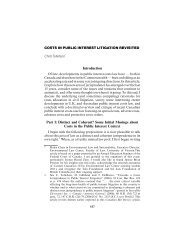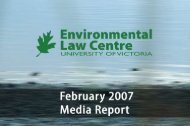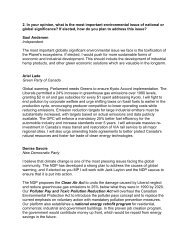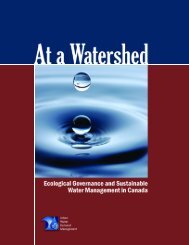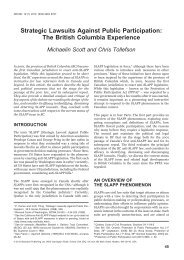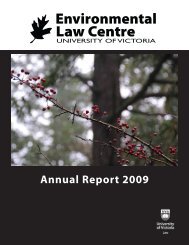Peeling back the Pavement - POLIS Water Sustainability Project
Peeling back the Pavement - POLIS Water Sustainability Project
Peeling back the Pavement - POLIS Water Sustainability Project
Create successful ePaper yourself
Turn your PDF publications into a flip-book with our unique Google optimized e-Paper software.
Photo: Capital Regional District, BC<br />
BOX 1: WHY SHOULD WE CARE ABOUT STORMWATER?<br />
We don’t normally think of rainfall as pollution. But, we have built our cities in a way that<br />
transforms rainwater into an agent of environmental and human harm: stormwater runoff.<br />
Stormwater runoff causes a large proportion of urban water pollution. In Washington<br />
State, for example, <strong>the</strong> United States Environmental Protection Agency estimates<br />
that more than 100,000 pounds of toxic chemicals are washed into Puget Sound via<br />
stormwater runoff every day.<br />
The transformation of rainwater into polluted stormwater occurs in stages as it flows<br />
through our urban spaces. The first stage is <strong>the</strong> creation of “hard” surfaces in cities,<br />
such as roofs, driveways, patios, sidewalks, parking lots, and road networks.<br />
In <strong>the</strong> second stage, heavy metals, PCBs, oils, grease, antifreeze, solvents, pesticides,<br />
herbicides, fertilizers, road salt, detergents, and pet waste collect across <strong>the</strong> urban<br />
landscape. When heavy rains sweep across a city’s hard surfaces, <strong>the</strong>se pollutants are<br />
picked up and washed away.<br />
The last salmon documented in Bowker Creek in British Columbia’s<br />
Capital Regional District. Due to urbanization and stream<br />
degradation, <strong>the</strong> creek no longer supports salmon populations.<br />
But, <strong>the</strong>re is no “away.”<br />
In <strong>the</strong> final stage, <strong>the</strong><br />
storm drainage system<br />
rapidly conveys <strong>the</strong><br />
polluted runoff—often<br />
without treating it—to<br />
<strong>the</strong> nearest body of<br />
water where it is flushed<br />
into <strong>the</strong> aquatic ecosystem.<br />
Stormwater runoff<br />
impacts urban ecosystems.<br />
It can destroy <strong>the</strong><br />
spawning grounds of<br />
salmon and o<strong>the</strong>r fish, decrease stream baseflows, erode stream banks, and increase<br />
<strong>the</strong> water temperature of streams. Numerous studies link rapid decline in water quality<br />
and stream health to uncontrolled stormwater runoff from areas in which <strong>the</strong> total<br />
impervious surface area exceeds 10 per cent of <strong>the</strong> total watershed area (known as<br />
“The 10% Rule”).<br />
To make things worse, in older municipalities stormwater runoff and sewage may be<br />
carried in <strong>the</strong> same pipe, which means bodies of water can become contaminated<br />
with fecal coliforms. An even bigger risk occurs when stormwater mixes with sewage<br />
and contaminates drinking water supplies. This is an issue in many places and fixing<br />
it may necessitate <strong>the</strong> expenditure of millions—or even billions—of dollars. For example,<br />
<strong>the</strong> cleanup costs of <strong>the</strong> stormwater-related impacts at Ontario’s 16 Remedial<br />
Action Plan sites were estimated to be $2.5 billion. Sources on page 65<br />
5



